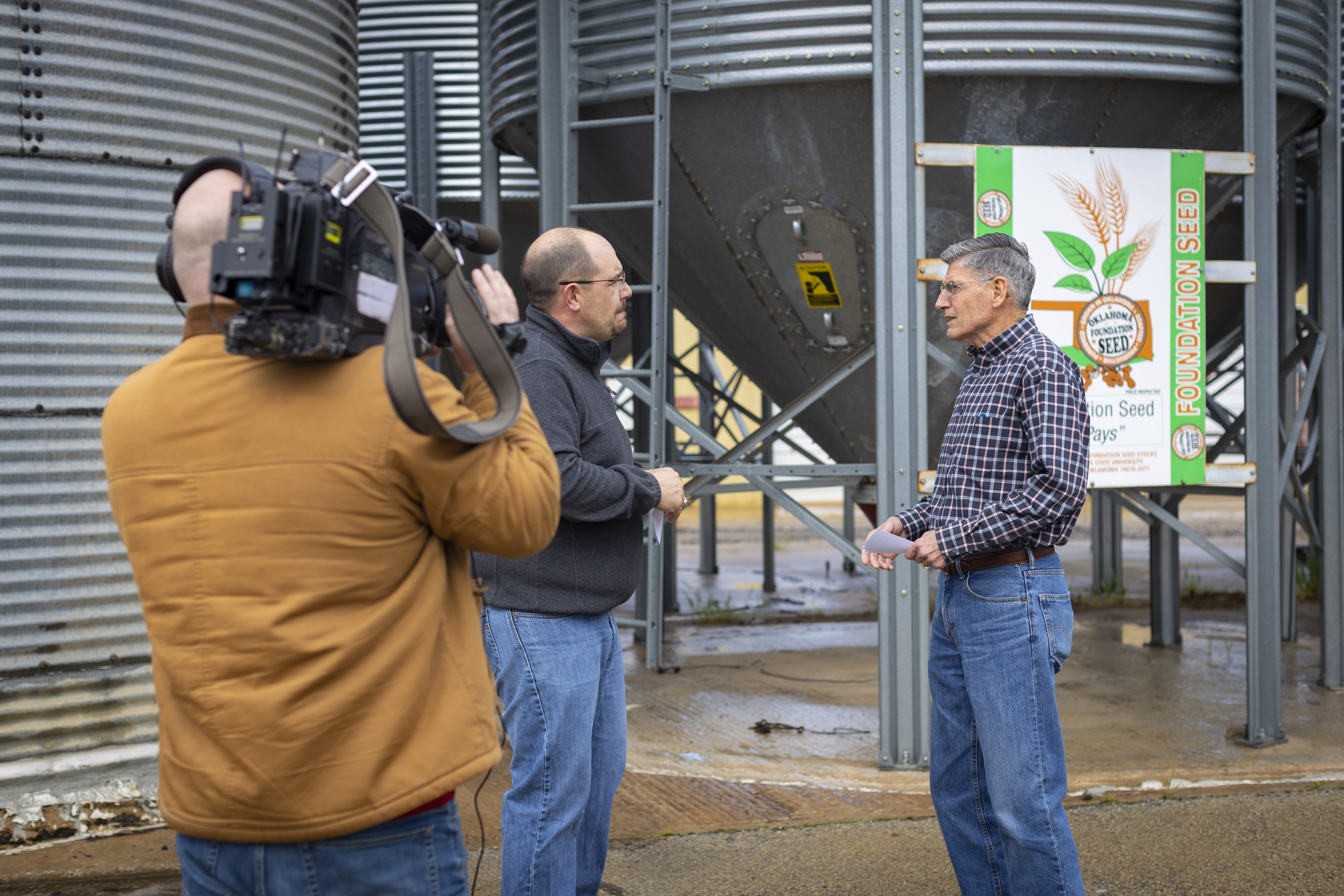There is a new blog post out on the Southern Plains Perspective by Clay Pope talking about climate smart agriculture. Read below!
If you want to start an interesting discussion on social media, just put out a press release or flyer abo…

Aug 12
There is a new blog post out on the Southern Plains Perspective by Clay Pope talking about climate smart agriculture. Read below!
If you want to start an interesting discussion on social media, just put out a press release or flyer abo…
Aug 12

By Trisha Gedon
With extreme heat and little rain still on the horizon for Oklahoma, gardeners may need to alter their fall garden plans.
“There’s nothing better than fresh produce throughout most of the year, but the lack of rainfall coupled with excessive heat may put a damper on successful fall gardening,” said David Hillock, Oklahoma State University Extension consumer horticulturist. “Typically, some of the best quality garden vegetables in Oklahoma are produced and harvested during the fall season when the warm days are followed by cool, humid nights.”
In ideal conditions, Hillock said plant soil metabolism is low; therefore, more of the food manufactured by vegetable plants becomes high-quality produce. Unfortunately, the current climate across much of the state involves high soil temperature, high light intensity and rapid drying of soil.
“This can be a problem for gardeners because achieving a full stand of plants in these extreme weather conditions may require special treatment,” he said.
“Gardeners may have to employ strategies such as shade row covers when seeding, along with supplemental watering to reduce soil temperature to aid in seed germination.”
Vegetable seeds are also vulnerable to the hot soil surface exposed to the summer sun.
“In order for viable seeds to germinate or sprout, they must have the proper temperature, adequate moisture and sufficient oxygen,” Hillock said.
Shade row covers can be made from burlap and a few stakes, said Laura Payne, horticulture specialist in the OSU Extension Payne County office.
“The burlap still allows light through but diffuses the heat on the tender plants,” Payne said. “Gardeners can also use screen wire strips or boards to cover the rows, which will moderate both soil temperature and soil moisture. Remove the covers after the seedlings emerge.”
Another option to help stave off the heat is creating deeper furrows in which to plant. This allows the seed to germinate in cooler soil. Even then, gardeners will need to supplement with extra irrigation to ensure the soil remains moist at seed depth.
Season extension methods, such as high tunnels or hoop houses, will help, especially if planting is delayed a few weeks to avoid excessive heat.
While daylight hours are still very warm this time of the year, nighttime temperatures are slightly cooling off, allowing plants to recover in the evening. Payne said the cooler evening temperatures will help with the establishment of a fall garden, but once seeds are sown, irrigate adequately. A garden’s soil dries out quickly during the day.
Gardeners who use transplants should condition them by reducing the amount of water supplied and exposure to full sunlight. Hillock said this process can take three to five days.
“When you’re ready to plant the transplants, do so in the late afternoon or early evening when it’s cooler to help reduce transplant shock,” he said. “Water the plants as they are set. A water-soluble fertilizer can be used if necessary.”
Typical fall vegetables to plant include broccoli, leeks, onions, peas, radish, kale, cabbage, collards, kohlrabi and cauliflower.
Casey Hentges, host of Oklahoma Gardening, has more tips for planting a fall garden. Additional gardening information is available from OSU Extension.
OSU Extension uses research-based information to help all Oklahomans solve local issues and concerns, promote leadership and manage resources wisely throughout the state’s 77 counties. Most information is available at little to no cost.
Aug 12
Click here to listen to audio
At the Women in Agriculture Conference, Radio Oklahoma Ag Network Intern, Cheyenne Leach sat down with the Made in Oklahoma Program Coordinator, Jenna Brinlee and talked about the MIO Program and upcoming …
Aug 12
Click here:
Recently, NASDA hosted a significant training session at one of Michigan State University’s research farms. NASDA and its development team, made up of food safety and horticulture specialists from five land grant univ…
Aug 12

The U.S. Department of Agriculture (USDA) today announced it is awarding $197 million for 41 locally led conservation projects through the Regional Conservation Partnership Program (RCPP). RCPP is a partner-driven program that leverages partner resources to advance innovative projects that address climate change, enhance water quality, and address other critical challenges on agricultural land.
“Our partners are experts in their fields and understand the challenges in their own backyards,” Agriculture Secretary Tom Vilsack said. “Through RCPP we can tap into that knowledge, in partnership with producers and USDA, to come up with lasting solutions to the challenges that farmers, ranchers, and landowners face. We’re looking forward to seeing the results of public-private partnership at its best, made possible through these RCPP investments.”
The projects funded today are awarded under two different RCPP funding opportunities: RCPP Classic and RCPP Alternative Funding Arrangements (AFA). RCPP Classic projects are implemented using NRCS contracts and easements with producers, landowners and communities, in collaboration with project partners. Through RCPP AFA, partners have more flexibility in working directly with agricultural producers to support the development of new conservation structures and approaches that would not otherwise be available under RCPP Classic.
See the list of 2022 RCPP projects or view the interactive map.
As part of each project, partners offer value-added contributions to amplify the impact of RCPP funding in an amount equal to or greater than the NRCS investment.
Private landowners can apply to participate in an RCPP project in their region through awarded partners or at their local USDA service center.
More Information
First authorized in the 2014 Farm Bill, RCPP has leveraged partner contributions of more than $1 for every $1 invested by USDA, resulting in nearly $3 billion collectively invested in natural resource conservation on private lands. Since inception, RCPP has made 589 awards involving over 3,000 partner organizations. Currently there are 401 active projects, with at least one active project in every state and area. Successful RCPP projects provide innovative conservation solutions, leverage partner contributions and offer impactful and measurable outcomes.
For more information about RCPP, visit the NRCS website.
RCPP is part of NRCS’ broader effort to engage partners. For example, NRCS recently announced it will invest $35 million this year through the Conservation Innovation Grants (CIG) program. Through CIG, grantees work to address our nation’s water quality, water quantity, air quality, soil health and wildlife habitat challenges, all while supporting agricultural production.
USDA touches the lives of all Americans each day in so many positive ways. In the Biden-Harris administration, USDA is transforming America’s food system with a greater focus on more resilient local and regional food production, fairer markets for all producers, ensuring access to safe, healthy and nutritious food in all communities, building new markets and streams of income for farmers and producers using climate smart food and forestry practices, making historic investments in infrastructure and clean energy capabilities in rural America, and committing to equity across the Department by removing systemic barriers and building a workforce more representative of America. To learn more, visit www.usda.gov.
Aug 12
The National Corn Yield Contest (NCYC) is nearing the August 17 entry deadline. The National Corn Growers Association (NCGA) challenges you to participate and be a part of its history.
“Our crops in Nebraska have been through a l…
Aug 12
Oklahoma’s Agricultural Education Instructor and Oklahoma State University Extension Educators will be honored at the 38th Annual Oklahoma Cattlemen’s Association (OCA) Ranch Rodeo. The event takes place August 19 and 20 at the …
Aug 12

RON’s Dave Lanning has a pre-opening look at today’s agricultural Markets.
Click the audio tab below for today’s report.
Aug 12
Woodward Livestock Auction – Woodward, OK
Thu Aug 11, 2022
AUCTION
This Week 2,788
Last Reported 2,058
Last Yea…
Aug 11

This week on SUNUP is Dr. Kim Anderson, Oklahoma State University Extension grain market economist. During this week’s edition, Anderson provides his analysis of the grain markets after recent dramatic shifts and changes in prices.
“Let’s start with what caused the price increase,” Anderson said. “You go back to January of 2020; we had wheat prices down in the $4 range. We came through and here recently we had them up to $13.30.”
The move from around $4 to $8 was because of COVID, Anderson said and was a demand-driven move. Production in 2019 was a record at 28 billion bushels, Anderson said, and wheat used was 27.4 bushels.
“We built stocks that year but when you got to ‘20, you had a 1.3 billion bushel increase in demand and wheat production only increased by 500 million bushels,” Anderson said. “So, you had a shortage and we reduced stocks.”
We have had a slight decline in production this year, Anderson said but we’ve had record use because of hoarding food stocks.
“The last move from $8 to $13 I think was the war,” Anderson said. “Russia and Ukraine shutting the black sea- you took 30 percent of the wheat off the export market and that is going to have an impact. Then, there is inflation. Outside money moves into commodities when there is the fear of inflation and that is what we saw happen on that move up.”
Since mid-May, we have seen a $5 decline in wheat prices. Since that adjustment, Anderson said it is hard to say where prices will go from here.
“You look at northern Oklahoma, we are about $8.25, slightly lower than a dime or two if you are looking at ’23 prices,” Anderson said. “Southern Oklahoma is $7.75.”
When thinking about what prices are going to do, Anderson said to look at Russia.
“We have had Russia’s exports on wheat and other commodities where they were before the war started and Ukraine started shipping commodities a couple of weeks ago,” Anderson said. “I think a good thing to look at is the stocks to use ratio. The five-year average for the world is 39 percent. This year is 34 percent. So, you’ve got tighter stocks.”
We can’t build those stocks up until we get into the 2023 harvest, Anderson said, so he believes these prices will hold for a while and will range from 7 to 10 dollars.
This week on SUNUP:
• Becky Carroll, OSU Extension fruit and nut specialist, has a progress report on this year’s pecan crop.
• Wes Lee, OSU Extension Mesonet agricultural coordinator, predicts a break in this heat wave. Gary McManus updates the drought monitor map.
• Paul Beck, OSU Extension beef cattle specialist, says now is the time to make cattle management plans for the upcoming winter.
• Kim Anderson, OSU Extension grain marketing specialist, explains why the wheat market has been so volatile and where prices may land next.
• Mark Johnson, OSU Extension beef cattle breeding specialist, discusses retained ownership.
• Finally, we take a look at the unique partnership among the USDA, OSU Water Resources Center and Extension to combat the cattle fever tick.
Join us for SUNUP:
Saturday at 7:30 a.m. & Sunday at 6 a.m. on OETA-TV
YouTube.com/SUNUPtv
SUNUP.okstate.edu